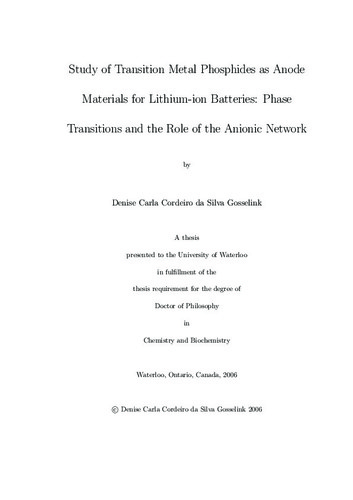| dc.contributor.author | Gosselink, Denise | en |
| dc.date.accessioned | 2007-05-08 14:05:05 (GMT) | |
| dc.date.available | 2007-05-08 14:05:05 (GMT) | |
| dc.date.issued | 2006 | en |
| dc.date.submitted | 2006 | en |
| dc.identifier.uri | http://hdl.handle.net/10012/2958 | |
| dc.description.abstract | This study highlights the importance of the anion in the electrochemical uptake of lithium by metal phosphides. It is shown through a variety of <em>in-situ</em> and <em>ex-situ</em> analytical techniques that the redox active centers in three different systems (MnP<i><sub>4</sub></i>, FeP<i><sub>2</sub></i>, and CoP<i><sub>3</sub></i>) are not necessarily cationic but can rest almost entirely upon the anionic network, thanks to the high degree of covalency of the metal-phosphorus bond and strong P-character of the uppermost filled electronic bands in the phosphides. The electrochemical mechanism responsible for reversible Li uptake depends on the transition metal, whether a lithiated ternary phase exists in the phase diagram with the same M:P stoichiometry as the binary phase, and on the structure of the starting phase. When both binary and lithiated ternary phases of the transition metal exist, as in the case of MnP<i><sub>4</sub></i> and Li<i><sub>7</sub></i>MnP<i><sub>4</sub></i>, a semi-topotactic phase transformation between binary and ternary phases occurs upon lithium uptake and removal. When only the binary phase exists two different behaviours are observed. In the FeP<i><sub>2</sub></i> system, lithium uptake leads to the formation of an amorphous material in which short-range order persists; removal of lithium reforms some the long-range order bonds. In the case of CoP<i><sub>3</sub></i>, lithium uptake results in phase decomposition to metallic cobalt plus lithium triphosphide, which becomes the active material for the subsequent cycles. | en |
| dc.format | application/pdf | en |
| dc.format.extent | 9614530 bytes | |
| dc.format.mimetype | application/pdf | |
| dc.language.iso | en | en |
| dc.publisher | University of Waterloo | en |
| dc.rights | Copyright: 2006,
Gosselink, Denise. All rights reserved. | en |
| dc.subject | Chemistry | en |
| dc.subject | Lithium-ion batteries | en |
| dc.subject | Transition metal phosphides | en |
| dc.subject | Anode | en |
| dc.subject | Mechanism | en |
| dc.title | Study of Transition Metal Phosphides as Anode Materials for Lithium-ion Batteries: Phase Transitions and the Role of the Anionic Network | en |
| dc.type | Doctoral Thesis | en |
| dc.pending | false | en |
| uws-etd.degree.department | Chemistry and Biochemistry | en |
| uws-etd.degree | Doctor of Philosophy | en |
| uws.typeOfResource | Text | en |
| uws.peerReviewStatus | Unreviewed | en |
| uws.scholarLevel | Graduate | en |

